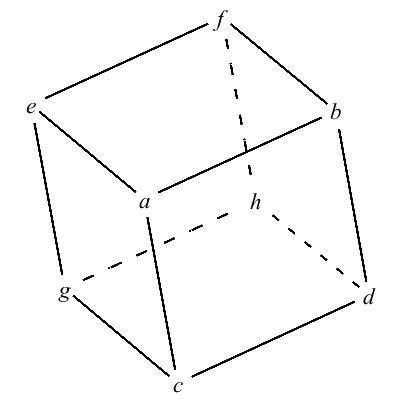 | ||
In mathematics, in number theory, Bhargava cube (also called Bhargava's cube) is a configuration consisting of eight integers placed at the eight corners of a cube. This configuration was extensively used by Manjul Bhargava, an Indian-American Fields Medal winning mathematician, to study the composition laws of binary quadratic forms and other such forms. To each pair of opposite faces of a Bhargava cube one can associate an integer binary quadratic form thus getting three binary quadratic forms corresponding to the three pairs of opposite faces of the Bhargava cube. These three quadratic forms all have the same discriminant and Manjul Bhargava proved that their composition in the sense of Gauss is the identity element in the associated group of equivalence classes of primitive binary quadratic forms. Using this property as the starting point for a theory of composition of binary quadratic forms Manjul Bhargava went on to define fourteen different composition laws using a cube.
Contents
Integer binary quadratic forms
An expression of the form
The form is said to be primitive if the coefficients a, b, c are relatively prime. Two forms
are said to be equivalent if there exists a transformation
with integer coefficients satisfying
Gauss composition of integer binary quadratic forms
Let
The class
The set of equivalence classes of primitive binary quadratic forms having a given discriminant D is a group under the composition law described above. The identity element of the group is the class determined by the following form:
The inverse of the class
Quadratic forms associated with the Bhargava cube
Let (M, N) be the pair of 2 × 2 matrices associated with a pair of opposite sides of a Bhargava cube; the matrices are formed in such a way that their rows and columns correspond to the edges of the corresponding faces. The integer binary quadratic form associated with this pair of faces is defined as
The quadratic form is also defined as
However, the former definition will be assumed in the sequel.
The three forms
Let the cube be formed by the integers a, b, c, d, e, f, g, h. The pairs of matrices associated with opposite edges are denoted by (M1, N1), (M2, N2), and (M3, N3). The first rows of M1, M2 and M3 are respectively [a b], [a c] and [a e]. The opposite edges in the same face are the second rows. The corresponding edges in the opposite faces form the rows of the matrices N1, N2, N3 (see figure).
The quadratic form associated with the faces defined by the matrices
The discriminant of a quadratic form Q1 is
The quadratic form associated with the faces defined by the matrices
The discriminant of a quadratic form Q2 is
The quadratic form associated with the faces defined by the matrices
The discriminant of a quadratic form Q3 is
Manjul Bhargava's surprising discovery can be summarised thus:
If a cube A gives rise to three primitive binary quadratic forms Q1, Q2, Q3, then Q1, Q2, Q3 have the same discriminant, and the product of these three forms is the identity in the group defined by Gauss composition. Conversely, if Q1, Q2, Q3 are any three primitive binary quadratic forms of the same discriminant whose product is the identity under Gauss composition, then there exists a cube A yielding Q1, Q2, Q3.Example
The three quadratic forms associated with the numerical Bhargava cube shown in the figure are computed as follows.
The composition
Also
Composition of cubes
The fact that the composition of the three binary quadratic forms associated with the Bhargava cube is the identity element in the group of such forms has been used by Manjul Bhargava to define a composition law for the cubes themselves.
Composition of cubic forms
An integer binary cubic in the form
Composition of pairs of binary quadratic forms
The pair of binary quadratic forms
